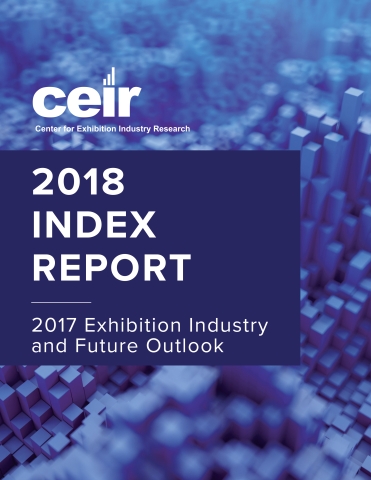CEIR Index Indicates Trade Show Industry Up 2 Percent for Full-year 2017

The Center for Exhibition Industry Research (CEIR) has released its 2018 CEIR Index Report, which analyzes the 2017 exhibition industry and provides an economic and exhibition industry outlook for the next three years.
The growth of the B2B exhibition industry accelerated along with the macro economy in 2017.
The CEIR Total Index, a measure of overall exhibition industry performance, increased by a moderate 2 percent, 1 percentage point higher than in 2016.
All four metrics rose in 2017, with real revenues leading at 2.9 percent above 2016. Attendees and net square footage rose 2.1 percent and 2 percent, respectively, whereas exhibitors gained 1.1 percent.
“Optimism in the business environment and robust economic and job growth should continue to drive exhibitions,” explained CEIR Economist Allen Shaw, Ph.D., chief economist for Global Economic Consulting Associates.
He added, “The exhibition industry is expected to finally enter into an expansion phase in 2018 with the Total Index surpassing its previous peak.”
As an objective measure of the exhibition industry’s annual performance, the CEIR Index measures year-over-year changes in four key metrics to determine overall performance, including net square feet (NSF) of exhibit space sold, professional attendance, number of exhibiting companies and gross revenue.
The CEIR Index provides data on exhibition industry performance across the following key industry sectors: Business Services; Consumer Goods and Services; Discretionary Consumer Goods and Services; Education; Food; Financial, Legal and Real Estate; Government; Building, Construction, Home and Repair; Industrial/Heavy Machinery and Finished Business Inputs; Communications and Information Technology; Medical and Health Care; Raw Materials and Science; Sporting Goods, Travel and Entertainment; and Transportation.
U.S. economic growth proved resilient again in 2017. GDP accelerated to 2.3 percent, a significant improvement over the 1.5 percent expansion registered for 2016 and an eighth consecutive year of moderate growth.
CEIR expects that GDP growth in the next few years will be propelled by a high rate of growth in personal consumption expenditures and improving private investment spending, in part due to recent tax cuts.
Strengthening, but moderate government expenditures, will provide an additional boost.
According to CEIR’s current projection, growth will rise to around 2.9 percent in 2018 before decelerating slightly to 2.7 percent in 2019 and 2.5 percent in 2020
Show organizers can use this latest data in tandem with the CEIR Index Event Performance Analyzer (IEPA) to measure their event’s performance.
Created with support from the Society of Independent Show Organizers (SISO), CEIR’s IEPA is designed to provide organizers a benchmark for how their exhibition is performing against the CEIR Index metrics.
The IEPA also compares the exhibition versus the overall performance of the industry sector and the exhibition industry overall.
A forecast update of the CEIR Index will be presented at Predict: CEIR’s Annual Exhibition Industry Conference taking place Sept. 13-14 at the MGM National Harbor in Oxon Hill, Md.
“The combination of the CEIR Index Report, CEIR Census and Event Performance Analyzer Tool is a powerhouse of resources to use in strategizing for the near future,” said Cathy Breden, CEO of CEIR.
She continued, “All this data is real-time information that, when factored into what the expert economists and futurists are telling us, allows for industry executives to feel confident in how they plan ahead. Exhibition organizer executives should plan to attend the CEIR Predict Conference to gain even more insight into what the next three to five years hold for the trade show industry.”
To purchase the complete 2018 CEIR Index Report, go HERE, or purchase the 2015 CEIR Census and 2018 CEIR Index as a package HERE.


Add new comment